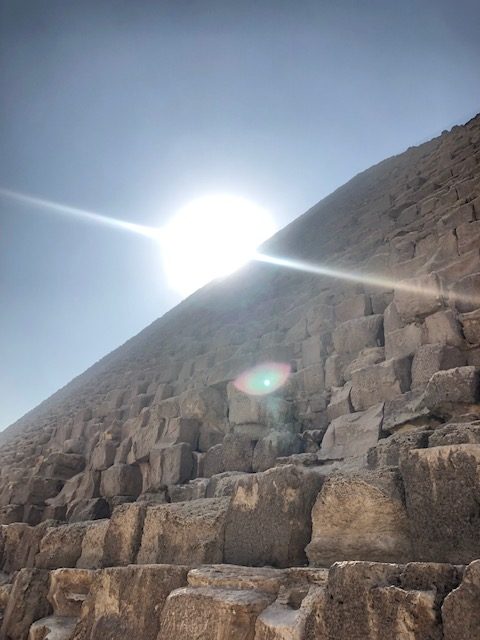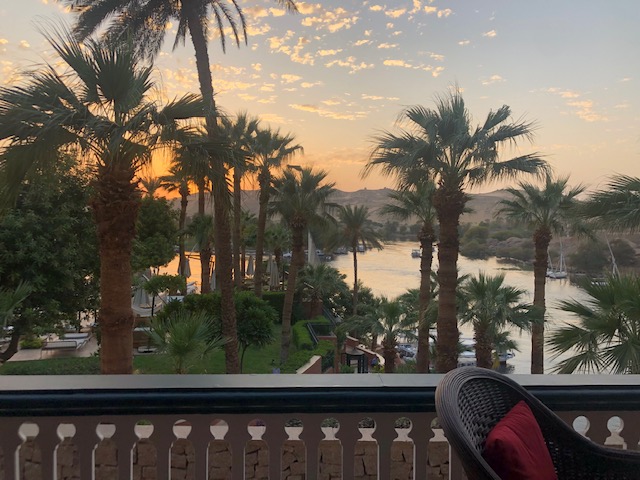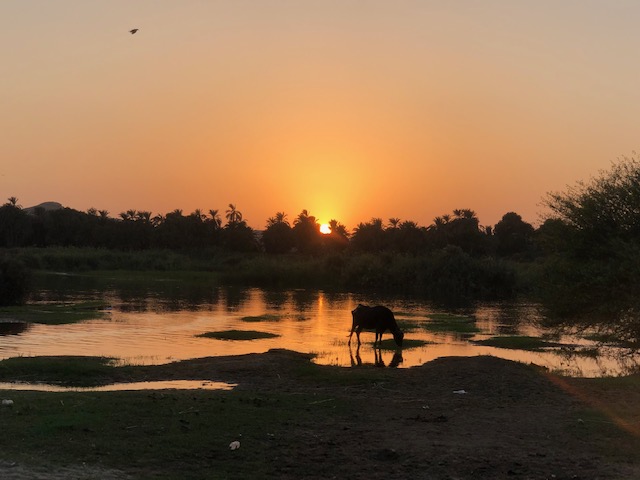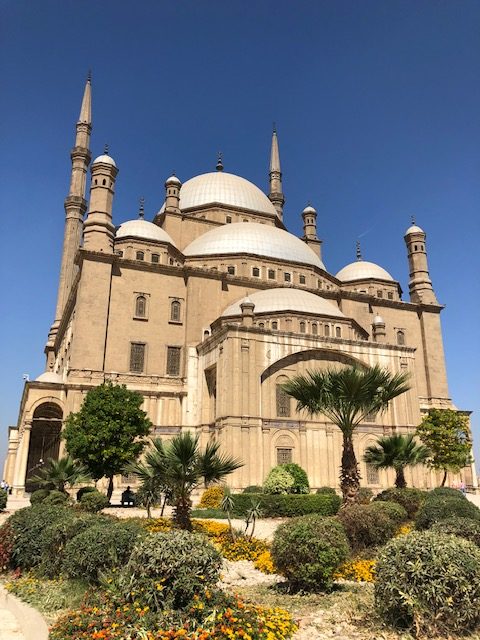Fun facts and tips about ancient Egypt and modern day life when traveling in Cairo, Giza, Aswan and Luxor. Including THE most important 2019 update!
- Most products at the traditional bazaars and markets are fake. China mass produces the designs and that is why you’ll see the same items over and over.
- For authentic products, Aswan is best for cotton and essential oils and Luxor is best for real stone and alabaster souvenirs, papyrus and pure 18K gold jewelry.
- Be ready to bargain! Haggling is anticipated and the initial price is always much higher than you’re expected to pay.
- The Egyptian pound is bilingual, with an Arabic side featuring Islamic buildings and an English side with famous landmarks or figures.
- There are 20.5 million people living in Cairo. That explains the “rush day” traffic.
- Driving in general tends to be lawless, with lines in the roads as mere suggestions. There are very few lights and people walk across the roads and highway at abandon.
- You’ll see dozens of people crammed into a small sedan or kids hanging on the side of buses or trucks. The same spectacle happens on trains, with the exception of riding on top which is now illegal.
- Despite, what seems to be a lack of rules, you’ll find a strong military and police presence in the city and at checkpoints when traveling between cities. They carry machine guns and don’t mess around. Do not take photos of any government vehicles otherwise they will ask to see your phone, best case scenario.
- The pyramids are the only “Ancient Wonder” still standing.
- The ancient Egyptian emphasis was always on the second life of the king, when the soul would be resurrected. This is why so much effort was spent on tombs and it’s rare to find palaces or big homes in ancient Egypt.
- The Cairo Museum is the oldest museum in the world, opening in 1901. There are renovations underway, but there are signs of age like no air conditioning. The new museum will open 2020 and house another collection.
- At museums, anything not uncased in glass can be touched (sometimes for good luck!)
- The hieroglyphics seen all over Egypt depict two popular themes: the daily life activity for noblemen and after-life scenes for Pharaohs.
- Gold was mainstream in ancient Egypt, hence the jewels, casings and everyday objects covered in gold. It was actually considered a bigger deal to have silver.
- There are metal detectors at the entrance of every landmark, destination or hotel. Most beep, but don’t have a purpose.
- Egyptians are pushy and can be aggressive, but they also want you to have a good time. They always say “Did you enjoy?”
- Ancient Egyptians lived on the East Bank and died on the West because the sun died on the western horizon every night. This is why all the tombs are on one side.
- Luxor is the site of ancient Thebes and is filled with more tombs and temples than any other area. Along the bank of Luxor is Karnak, a sacred site with the contributions of over thirty pharaohs, making it a huge and diverse area with grand columns, statues and obelisks. A classic example of each pharaoh trying to outdo the next.
- Egyptians LOVE bread. It is offered at every meal and sometimes it is the meal. “Carb heavy” is an understatement.
- Abu Simbel is a site with twin temples carved out of the mountainside in the 13th century BC to commemorate the reign of the Pharaoh Ramesses II and his queen Nefertari.
- The most interesting phenomenon occurs in the sanctuary at the far end of the Ramesses temple, when the sun reaches the pharaoh twice a year: on his birthday and coronation day. It’s one of the first cases of architecture and astronomy working together.
- As a result of the dam, UNESCO stepped in and saved 14 temples from being submerged or destroyed. There is one that still remains in the water but is in good condition. Abu Simbel is an extreme example, rebuilding a mountain and relocating the temple over the course of 5 years.
- The photo ban was lifted in many landmark sites in September 2019. Photos can be taken from camera phones in the museums, tombs and temples including Abu Simbel, the Cairo Museum and the Valley of the Kings.
- 95% of Egyptians live along the banks of the Nile, the longest running river in the world.
- The High Dam was built in the 1960s and changed everything about life in Egypt, including the control of floods, settlements and tourism.
- There are no crocodiles in the Nile from Aswan to Luxor because of the dam, but they do hang out in the lakes on either side.
- Although tourism has picked up, it is nowhere near the level it was before 2011. The biggest hint of this are the river boats that sit empty on the riverbank and the hotels that are often very quiet. Even if you time the pyramids, tombs and temples right, you can have areas to yourself.
- Feluccas, traditional Egyptian sailboats, can take a lot of time to get to A to B without any wind. Because there is no motor they have to slowly zig zag their way down the Nile River, which is heading north.
- In Eygpt, more tours and activities happen in the morning before the hottest part of the day. That means you’ll have more downtime in the afternoon.
- Not everything is going to work properly: power outlets, elevators, water, wifi and hours/timing tend to change on a whim. Plan on being flexible!
- Set expectations now! The main cities in Egypt are not beautiful. Buildings are crumbling, paint is peeling and trash is everywhere. The landmark and historical sites are taken care of though.
- Coffee is not Egypt’s strong suit and the tea is most often just Lipton. Your best bet is asking for the Egyptian mint tea which at least has the possibility of locally grown mint.
- Valley of the Kings is a highlight in Luxor. There are 63 tombs that have been found. Ramses VIII is still undiscovered so keep an eye out!
- Most have been raided and left empty, with the exception of three tombs: two noblemen now located in the Cairo Museum and the famous King Tut.
- The Valley location was chosen as a less obvious landmark to prevent raiders, but in keeping with a (natural) pyramid shape.
- The size of the tombs are often based on how long the kings lived. If the tomb is big, covered in carvings and painted, and deep underground, they likely lived longer. King Tut’s tomb is considered small having only ruled for 11 years and dying at age 19.
- Archaeologists are making discoveries every day and there’s still so much to uncover!
Click here for my experience in Egypt.






